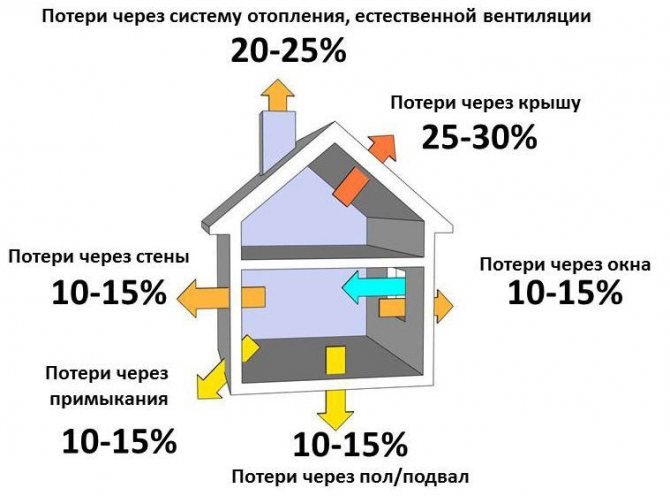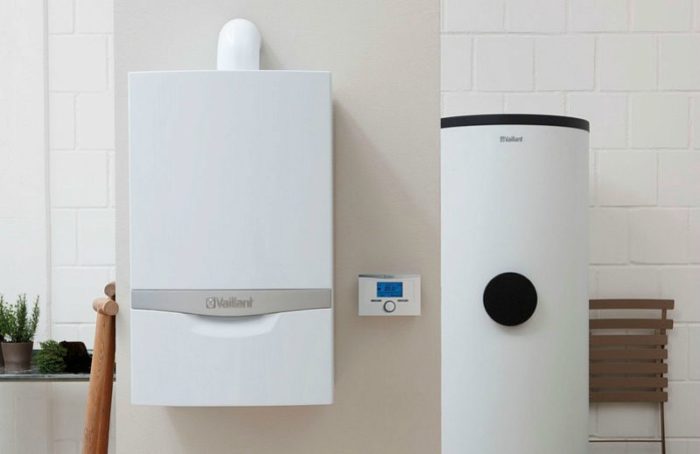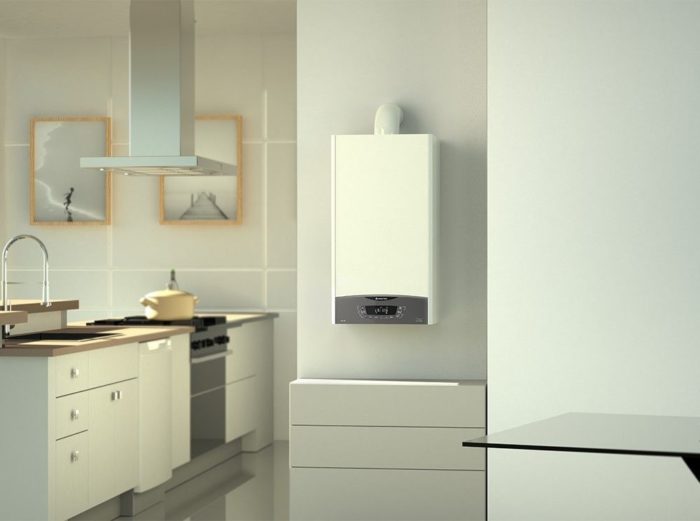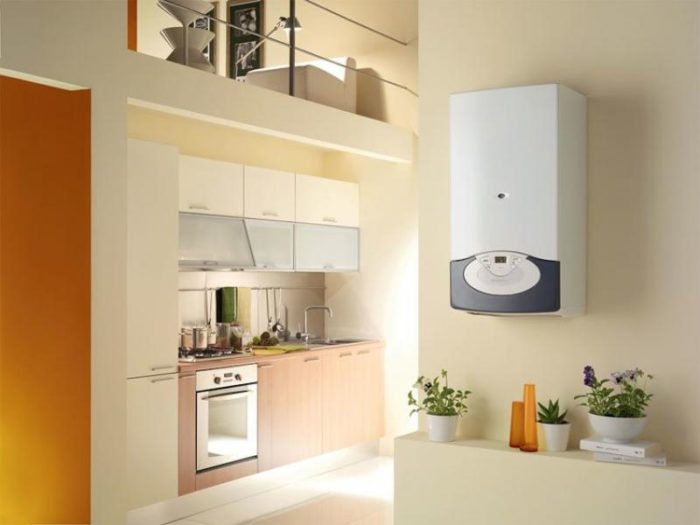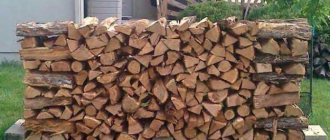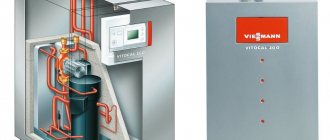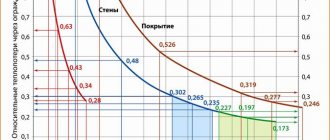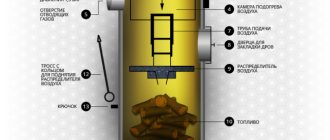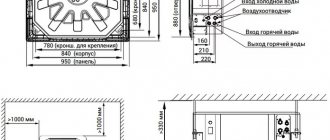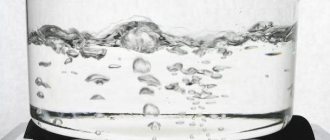What determines gas consumption
An important issue on which material costs depend. Factors:
- boiler power;
- heat losses;
- calorific value of gas.
The boiler is the main heat generator; comfort and gas consumption depend on performance. The heater can be:
- convector;
- with an open combustion chamber;
- with a closed combustion chamber;
- condensation.
Convector - air heater. Convection is used: forced, natural. The gas burns in the combustion chamber, passing through the heat exchanger, is discharged to the outside. Cold air enters the heat exchanger through the lower part of the housing, heats up, and goes out into the room. Fans are used to speed up the process.

Gas convector
The firebox can be of two types:
- open;
- closed.
In an open firebox, oxygen is taken from the room air, the combustion products are removed outside.
Heaters with an open chamber can be installed in non-residential areas. This is related to safety.
In a closed chamber, oxygen enters together with the outside air and is discharged outside. The systems are safer, more productive. Convectors are characterized by low efficiency, about 86%, are used to heat small rooms.


Boiler diagram with: a) open; b) closed firebox
Gas boilers are similar in structure, but they heat water, which has a higher thermal conductivity than air, and the efficiency is higher. The difference is the way of transferring heat. The water heated in a heat exchanger (another heat carrier) is transferred by a pump to radiators in different parts of the house. It is possible to transfer heat over long distances. The efficiency of boilers with an open chamber is 88%, a closed one - 92%.
In order to increase the efficiency of the boiler, they try to remove heat from the combustion products. They came up with a condensing boiler. It works like a conventional one, but has two heat exchangers: the first is a conventional one, it takes heat from the combustion products, the second is installed in the path of the exhaust gases. The heat carrier taking heat from gases must have a temperature not higher than 55 ° C. Exhaust gases cool down, water is released - condensate, which can be used for technical purposes. The efficiency can be increased up to 96%.


How does a gas condensing boiler work
The lower the heat loss, the lower the gas consumption.
How much energy does a home heating system consume?
Heat losses include conditions, factors that lower the temperature in the house. It is impossible to take everything into account, let's highlight some:
- geographic point;
- heated area;
- if the apartment is heated - where it is located;
- exterior wall material;
- ventilation;
- heat consumption for additional needs.
The first point refers to the climatic zone, the further north, the greater the loss. The location of the house on the ground. For example, a house located separately, on a hill, is exposed to more wind loads than a house protected by other buildings in a low place.
The second point is more correctly called the heated volume, the increase in the ceiling increases the area of the outer walls, which introduces losses. The exception is that a basement room of the same volume loses much less heat than the upper room.
The apartment in the center of the house has losses only through one outer wall, the upper corner one - two street walls plus a ceiling connected to the attic, a roof. The southern premises receive additional heating from the sun, which cannot be said about the northern location.
Thermal insulation of walls is the most important point in saving heat. Most of all come into contact with the outside air, even a slight decrease in heat loss can give results.When building, designing, it is worth thinking about the building material. If the building is built, it is necessary to assess the thermal conductivity of the walls, insulate it. The costs will pay off by reducing gas consumption.


Heat loss diagram
Ventilation is a weak point. Correctly adjusted, serviceable will provide the necessary oxygen, save the generated heat. Some people use window, door slits as ventilation, however, the approach is not justified by common sense. Cracks can appear in a wall that has not been renovated at home.
The last item on the list includes gas stoves, hot water supply, hot water supply. Heating takes place indirectly through an additional heat exchanger. The higher the DHW consumption, the more gas will be consumed.
After determining the heat loss, the energy to be replenished can be calculated. There are formulas, tables, but they are difficult to understand. You can use the simplified diagram shown in the table:
| External surfaces | Loss, W / m2 |
| wall, wall with window | 100 |
| corner two walls, window | 120 |
| two walls, two windows | 130 |
Shown are losses for external walls, windows, you must select a line, measure the area of the room. For example, if we have a wall with one window, the losses will be 100 W / m2. The length of the room is 4 m, the width is 2.75 m, the work is 11 m2. Multiply by 100 W / m2, we get 1100 W or 1.1 kW. Calculations are carried out in all rooms, the result is summed up.
How to save
The financial costs of maintaining a comfortable microclimate in the house can be reduced by
:
- additional insulation of all structures, installation of double-glazed windows and door structures without cold bridges;
- installation of high-quality supply and exhaust ventilation (an incorrectly executed system can cause increased heat loss);
- use of alternative energy sources - solar panels, etc.
Separately, it is worth paying attention to the advantages of the collector heating system and automation, thanks to which the optimal temperature level is maintained in each of the rooms. This allows you to reduce the load on the boiler and fuel consumption during warming outside, reduce the heating of the coolant that is supplied to the radiators or the underfloor heating system in unused rooms
If the house has a standard radiator system, a sheet of thin foamed heat insulator with an outer foil surface can be glued to the wall behind each heating device. Such a screen effectively reflects heat, preventing it from escaping through the wall to the street.
A set of measures aimed at improving the thermal efficiency of a house will help to minimize energy costs.
How to avoid heat loss
Fuel consumption for heating a house depends on the total area of the heated premises, as well as the heat loss coefficient. Any building loses heat through the roof, walls, window and doorways, the floor of the lower floor.
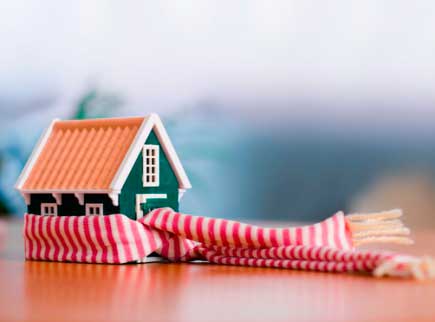

Respectively, the level of heat loss depends on the following factors
:
- climate features;
- wind roses and the location of the house relative to the cardinal points;
- characteristics of materials from which building structures and roofs are erected;
- basement / basement;
- the quality of floor insulation, wall structures, attic floors and roofs;
- the number and tightness of door and window structures.
Thermal calculation of the house allows you to select boiler equipment with optimal power parameters. In order to determine the heat demand as accurately as possible, the calculation is performed for each heated room separately. For example, the heat loss coefficient is higher in rooms with two windows, in corner rooms, etc.
Note! The power of the boiler is selected with a certain margin relative to the calculated values obtained. The boiler unit wears out and breaks down faster if it regularly works to the limit
At the same time, an excessive power reserve translates into an increase in financial costs for the purchase of a boiler and an increased fuel consumption.
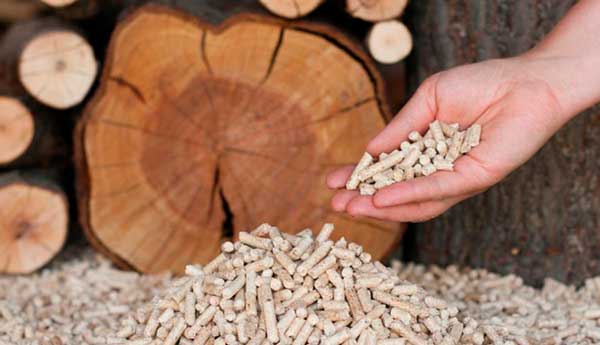

How much gas needs to be burned to generate 1 kW
Depends on the calorific value of the fuel, the higher the indicator, the less fuel is needed. Heat is usually measured in J / kg, J / m2, J / L. The task is to determine the calorific value, to bring it to the required value. For heating use:
- methane;
- propane;
- butane;
- propane-butane.
To convert J to kW, use the ratio: 1 MJ = 0.278 kW / h.
Propane, butane, their mixture have different purification, calorie content varies. The volume and weight of the gas are very variable. Temperature, pressure greatly affect the performance. This is due to the large expansion coefficient, in comparison with water, 16 times more. To compare indicators, the test substance must be under the same conditions (temperature, pressure, product purity).


Calorific value of fuel
Another indicator that affects the amount of heat received is the boiler efficiency. Depending on the design, the average performance is determined:
- gas convector 86%;
- open type boiler 88%;
- closed combustion chamber 92%;
- condensing gas boiler 96%.
The given figures are averaged, the performance is influenced by many factors, for example, the material of the heat exchanger. May be:
- steel;
- cast iron;
- aluminum;
- copper.
The efficiency may deteriorate, the heat exchanger plates are burnt, clogged with soot.


Gas heat exchanger
The main factors affecting the gas consumption in the boiler
A gas-fired heating device can consume working material with different intensities. This can be influenced by the following factors:
- Thermal power generated by the device
- Efficiency or completeness of conversion of internal gas energy into thermal energy,
- The load with which the heating device operates at a particular moment in time. So in winter, gas consumption in boilers can increase. Also, the consumption of gas boilers for heating running water increases with its active use.
- The amount of heat loss in your room has a significant impact on the consumption of energy carriers in gas boilers. Poorly closed doors, non-insulated windows and walls, drafts on the floor or ceiling - all this will negatively affect the gas consumption in your heating boiler, will inevitably lead to increased costs and hit your wallet.
How to calculate the gas consumption for heating for a certain period?
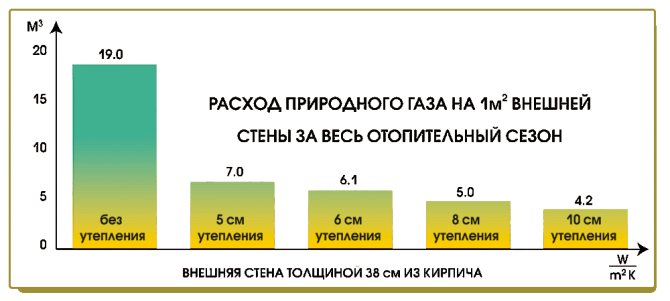

gas consumption calculation
The easiest way to understand the amount of gas consumed over a certain period is using a simple example. Let's say we have a task to build gas heating for a house with a heated area of one hundred square meters. Approximately one hundred watts of heating power of the heating device should be consumed for approximately every square meter of the heated room. Thus, our planned house for heating will require a power of about 10 kilowatts (10,000 watts). With constant operation of heating equipment for a full month of work, you will use 7200 kilowatts. But in reality, heating equipment (unless your house is located in the far north) will not work for more than half of a full day. Consequently, about 3600 kilowatts will be spent on heating our house per month. Depending on the climatic conditions prevailing in your area, you can calculate the required amount of heat energy that will be spent on heating your home during the cold period.
A good gas boiler will consume about 0.1 cubic meters of gas to generate one kilowatt of heat energy.Based on these figures and the cost of a cubic meter of gas in your area, you can easily calculate the amount of gas required to heat your home.
Naturally, these calculations will be quite approximate and can vary both up and down, depending on a variety of conditions.
Determine if there is a gas overrun in our heating system?
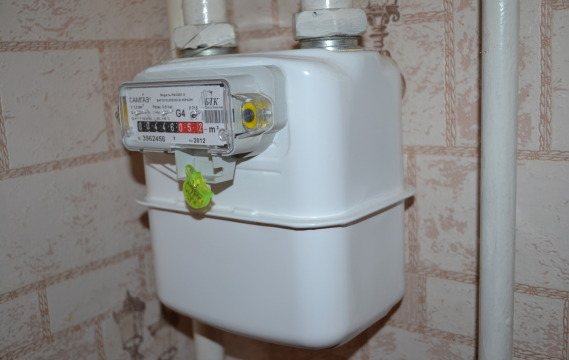

Gas meter
Let's define the main signs that will indicate that gas overruns will occur in our heating system. The presence of these signs should force a prudent owner to take measures to increase the efficiency of the heating gas boiler:
- In the room where the heater is located, overheating of the ambient air is recorded. Also, a similar sign may be overheating of the outer surface of the heating device. However, the combustion products that come out of the boiler are not overheated. In order to increase the efficiency of the boiler in this case, it is necessary to install an air duct that will move the heated air into the heated rooms. Note that heated air tends to move upward. Thus, it will be better if the heated room is located above the installation site of the gas boiler. In other cases, you will have to arrange forced circulation of heated air. Please note that the heated air must be taken from the upper part of the boiler room and distributed to the lower part of the heated room.
- Also, a negative sign may be overheating of the combustion products of the heating boiler. In this case, it is necessary to adjust the settings of the heating device or completely replace it.
How to achieve economical gas consumption?
In order to more economically use the incoming energy resources, you should take the following measures:
- Purchase a heating device with increased efficiency,
- Modify the heat exchanger of the heating system. The built-in circulation pump significantly increases its efficiency. In order to ensure the smooth operation of the pump - place a water filter in front of it,
- It is imperative that a heat exchange unit with forced air circulation must be installed in systems with a universal power supply capable of operating on any type of fuel.
- When installing radiators, make sure that there is a heat-reflecting surface behind it on the wall. Bare concrete will reduce the efficiency of a working radiator by about 30 percent. A good solution would be to install fans at the bottom of the radiators that move warm air deeper into the room.
- Installation of automatic control systems on heating devices significantly increases their efficiency. But such automation requires, as a rule, a constant connection of the power source.
Average statistical gas consumption per month, day, hour
How to calculate how much gas is consumed? It can be done approximately, it is impossible to consider all the factors Data:
- calorific value of gas;
- Heater efficiency;
- heat loss of the building;
- additional costs (for example, hot water supply system for hot water supply).
For the calculation, you can use the formula: V = Q / (q x efficiency / 100).
A simplified version, you can get an idea of the upcoming costs. Explanation of designations:
- V is the calculated gas volume;
- Q is the required heat;
- q is the calorific value of the gas.
The volume of gas strongly depends on temperature, pressure; the volume of gas vapors at normal atmospheric pressure is taken into account. From 1 kg of the liquid phase of the gas, approximately 450 liters of vapor are obtained. To calculate how much heat is needed for heating, the heat loss of walls, doors, windows, floor, ceiling is calculated. If there is ventilation, add an indicator. When using hot water, the V value is multiplied by a factor of 1.15.The calorific value of the gas is determined from the tables, converted to kW.
As an example, you can calculate for a house with an area of 100 m2. Based on the table, we determine the average loss of 120 W / m2h, translate into kilowatts, it turns out 0.12 kW / m2h. Multiplying by the total area of the house, we get 12 kWh - the Q indicator.
A liquefied mixture of propane-butane gas with a calorific value of 11.5 kW / kg is used. Boiler with a closed chamber, productivity 92%. It remains to insert indicators into the formula. V = 12: (11.5 x 92: 100) = 12: 10.58 = 1.13 m3 / h. It will turn out to be 1.13 x 24 = 27.12 per day, 813 m3 per month.
The result will be about half that. Heat losses are taken for extreme conditions - the coldest day in winter. There are not many such days in the heating season, the result is usually divided by 2.
How to calculate gas consumption for heating a home
When calculating the flow rate, two main parameters are taken into account. This is the power of the unit and the area of the heated room, the higher these figures, the greater the consumption of "blue" fuel. When choosing the boiler power, the calculation of 1 kW of power per 10 sq.m. is taken into account.
How to determine (calculate) the amount of fuel consumption? In order to generate a power of 1 kW, on average, it is necessary to spend 0.112 cubic meters per hour of natural gas. When heating a room with a standard ceiling height and an area of 100 sq.m. a 10 kilowatt unit is required.
Multiplying the power of the device 10 kilowatts by 0.112 cubic meters, we get a gas consumption of 1.12 cubic meters per hour. But, in order for your device to not work constantly at full power, which will significantly reduce its service life, you should purchase a device with a slightly higher power.
In addition, it should be borne in mind that consumption figures may differ for units with the same power. It depends on the design features of the apparatus, the materials from which the boiler elements are made, the parameters of the protective and control devices. Below are the maximum values of main fuel consumption by different brands of boilers, the last digit in the model name means the unit's power.
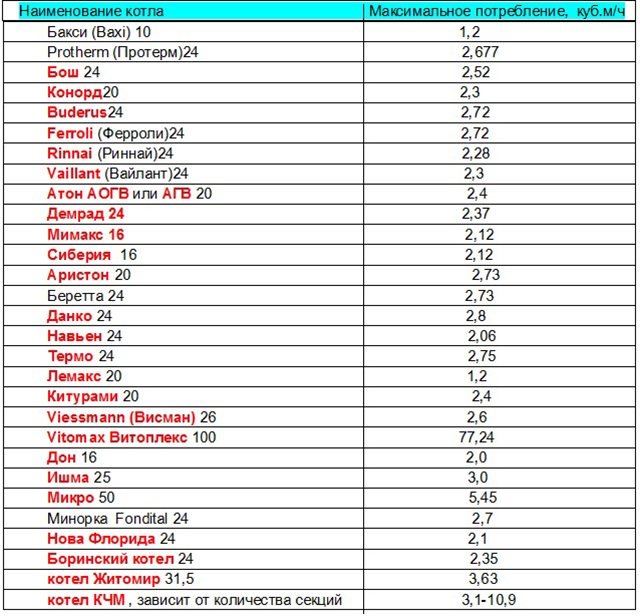

At first glance, the consumption is not very different for devices with the same power. But it will be very different if you calculate the volume for a month and, moreover, for a year.
How to reduce consumption
A powerful boiler makes it possible to quickly cover heat losses, however, the gas consumption increases. The issue can be partially solved by using a condensing boiler. However, the equipment is more expensive than analogs. A copper gas heat exchanger will require additional cash costs. Cheap natural gas can be used, however, the volume of gas consumption will increase. Practical tips for saving gas:
Better to reduce heat loss. Thorough sealing of windows, doors, insulation of the building frame, economical consumption of hot water will help to significantly reduce consumption.
Which boiler consumes gas more economically?
The answer is unambiguous - conditioned. Losses are contained in the release of warm burnt products into the atmosphere. For the rest of the boilers, the indicator is much higher. The gas unit is designed so that heat remains in the building. The efficiency will show how much heat remains in the room. Some manufacturers go for a trick, the boiler has an efficiency of more than 100%. It turns out that the boiler gives off more heat than the fuel can give - a complete absurdity.
To save on heating, you need to choose the fuel wisely, adjust the system, and insulate the building.


